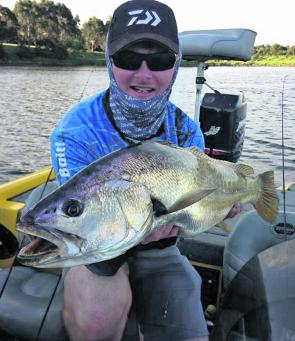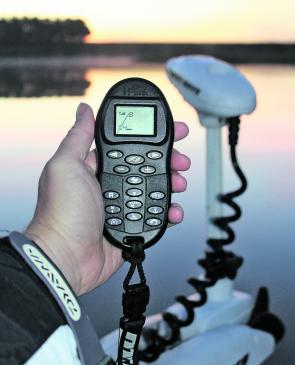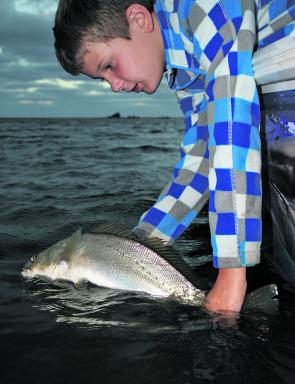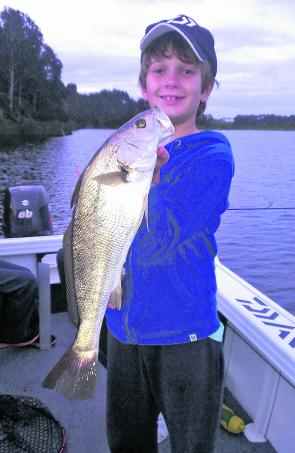Mulloway (Argyrosomus japonicus) are one of the most sought-after recreational fish species in temperate Australia. Over the last 12-18 months in particular, there has been increased interest in mulloway fishing with anglers all over Victoria recording unprecedented catches of juvenile mulloway.
These fish have been turning up in traditional mulloway strongholds, as well as other waters where they have been absent from for some time and it has been no exception in the southwest of the state. Mulloway have been captured in varying degrees in all the western district estuary systems from the Gellibrand right through to the Glenelg.
Interestingly, the Glenelg River, the strong hold of Victorian mulloway for many years when other areas were seemingly devoid of the species, hasn’t fished as well for mulloway in the last 18 months. It’s certainly not for lack of fish, as the river is swarming with them. It’s just the average size is well down with many anglers catching 10-20 undersize fish before a legal fish comes around. While frustrating now, it is definitely a great sign for the future.
Traveling east the Fitzroy River has often produced the odd mulloway, no surprise given the fish that get taken off the nearby beaches. However the river experienced a solid run of fish last summer, mostly just around size but with the odd decent fish to 5kg.
The Moyne River at Port Fairy has often had a consistent mulloway population, however targeting them can be a little more specialised than in other localities. The main reason is that with its wide open mouth it is much more tidal than the other local estuaries. You really need to target periods of slack water to put yourself in with a chance.
The Hopkins River was once a known producer of mulloway but consistent captures had been rare for almost a decade. Whilst not in ridiculous numbers you can, for the first time in a long time, go out and specifically target mulloway with a very good chance of catching one. I’ve caught fish recently from right down at the mouth to as far up as the estuary goes to at Torram Stones. Most fish are in just either side of 60cm but there have been enough 5-6kg fish landed, and stories of bigger fish lost, to make things interesting.
Other local estuaries like the Curdies, Gellibrand and Surrey rivers as well as Yambuk Lake, whilst not being locations you would actively target mulloway, have still had the odd fish show up recently. Given the propensity for mulloway to take the same lures that people are throwing for bream and EP in these systems, it makes sessions in these rivers all the more interesting.
With the minimum size of mulloway being 60cm many of these fish need to be carefully released back into the water. However there are also plenty of larger specimens giving lucky anglers a taste of how exciting hooking a decent mulloway in calm inshore or estuary areas can be.
So if you want to get out and try targeting some Western District mulloway then here are a couple of methods that work well and the best waterways to use these techniques.
Trolling live mullet is a popular way of targeting mulloway locally. The mullet trolling equation is not as simple as hanging a mullet out the back. The bait needs constant monitoring to make sure it hasn’t picked up weed. A mullet covered in weed is probably unattractive to the mulloway and is also likely to die quicker.
The rod is best placed in a horizontal style rod holder with the rod tip close to the water. Snap lock rod holder’s work well as the rod can be quickly released without giving the fish any slack line to throw the hook. I prefer to use a treble stinger hook set up as the mulloway will usually hook itself on the first run, even if the rod remains in the holder.
Once set up you need to be able to troll off quietly and it is here that the silence provided by an electric motor is essential. For years mulloway trollers used to row small boats or use inboard ‘putt-putt’ style boats with great success, as opposed to trolling behind a noisy outboard.
Without my trusty Minn Kota, I wouldn’t even attempt trying to seduce a mulloway on the troll. One of the major advantages is that the stability and control of the electric powered boat can allow you to hold over sounded fish, drop livies back into a hole or quickly go return over an area where a fish was encountered. Fishing from a boat propelled by and electric motor, rather than one stuck at anchor gives you the opportunity to instantly give chase should the need arise. Kicking the Minn Kota into gear and keeping the least amount of line between you and the fish can be crucial in landing a decent mulloway.
Another way of targeting mulloway is by fishing lightly weighted bait such as cut fish, fresh squid or spew worms. Of course fresh baits like spew worms are going to work best but can be hard to obtain. Don’t underestimate the effectiveness of buying a large block of pilchards and using them as bait/berley.
Thaw the pilchards and cube them, throwing out a handful at consistent durations. Place one on a unweighted hook and allow it to drift out on a slack line. It’s a technique we used to use a bit in the past when a block of pilchards could be picked up for around $5 (man, I’m getting old!), but have been revisiting a bit recently as it has been a fun way of fishing with the kids. They enjoy taking charge of the berleying process and there is usually enough bream around, which are also happy to wolf down a pilchard cube, to keep the action happening until a mulloway comes along.
Mulloway have always been seen as an elusive fish that is a live, or super fresh, bait proposition. The acquiring of this quality bait usually takes a great deal of time, and often is what separates consistent mulloway anglers from the rest.
Sourcing the bait, then presenting it well on the numerous occasions it can take before even one fish is caught, requires a dedication that many anglers simply are unable to manage. However, it is this preference for a live offering that makes mulloway a viable lure fishing proposition.
Essentially, working a lure imitates a live offering. If you manage to put a well presented plastic in front of an actively feeding mulloway there’s every chance it’s going to get eaten.
Advancements in delivery technique, due to improved quality of the terminal tackle, is also a major key in mulloway being taken on lures. But if you want to specifically target mulloway on cast artificial lures, whether hardbody, soft plastics or vibes, there’s a few extra things you can do.
The obvious thing would be to upsize your bream gear and in a way that is correct. However you don’t want to go upsizing too much. I’ve had most success when fishing lures only slightly larger than bream lures on bream tackle or slightly heavier. No need to dust off the barra or snapper gear. A VX 40/45 vibe instead of a 35, a 4” Gulp minnow instead of a 3”, upgrading leader from 5lb to 8lb is enough to make your cast offering appealing to a mulloway. It still remains small enough to make bream a by-catch when you are concentrating on mulloway.
Mulloway will also snap up bream size offerings with gusto so having a smooth drag and good knots, with the ability to give chase on the electric puts you in with a chance of landing an unexpectedly larger fish.
Combining casting a lure for bream and mulloway can be good option. Many boats today have live wells, which can be excellent keepers of live baits. When lure casting you may not be covering the water quickly enough to keep a trolled mullet up out off the bottom. Placing the live mullet under a float is a variation that sometimes needs to be made to alleviate the livey becoming snagged in the bottom.
Release the float a considerable distance out the back of the boat and it will slowly track along behind as you focus on bream fishing out the front. It can give you an awful fright at times if it goes off when everyone in the boat has been focusing on bream fishing and forgotten you had the trap set 40m behind you.
If I am doing some serious trolling for mulloway I will usually source live bait. However trolling deep diving hardbodies, like the Daiwa Double Clutch, on light gear can produce mulloway, as well as being appealing to bream and estuary perch to keep things interesting.
Reads: 3715
Mulloway have always been seen as an elusive fish that requires live, or super fresh bait, which makes them perfect to target with a well worked lure.

Mulloway have been captured in all the western district estuary systems.

An electric motor is a huge benefit when chasing mulloway.

Carefully release all mulloway under 60cm.

Small mulloway are a great challenge for young anglers.

Soft plastics intended for bream and estuary perch are often taken by mulloway – not a bad by-catch!




